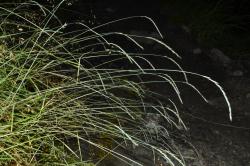- Taxon
- Gallery
- ≡ Asprella laevis Petrie, Trans. & Proc. New Zealand Inst. 27: 406 (1894 [1895]) – as Asprella lævis
- ≡ Hystrix laevis (Petrie) Allan, Bull. New Zealand Dept. Sci. Industr. Res. 49. 88 (1936)
- ≡ Cockaynea laevis (Petrie) Zotov, Trans. Roy. Soc. New Zealand 73: 234 (1943)
- ≡ Elymus laevis (Petrie) A.Löve & Connor, New Zealand J. Bot. 20: 184 (1982)
Perennial grass with long stolons, rooting and shooting at nodes, inflorescences narrow and nodding or drooping on long slender culms. A species of grasslands. Leaf-sheath 5–10 cm, with retrorse hairs 0.5 mm, or glabrous; keeled. Auricles absent or minute, 0.15–0.25 mm, scarcely clasping. Ligule 0.5–1 mm, lacerate; prominent. Leaf-blade 15–25 cm × 1.5–2 mm, flat, thin, abaxially with distinct midrib, glabrous or occasionally with hairs 1 mm beside ribs or shortly retrorse prickle-toothed, adaxially with prickle-teeth on ribs occasionally with hairs 0.5 mm; margin glabrous or shortly toothed. Culm 50–75 cm, nodes inconspicuous, internodes glabrous, slender. Inflorescence very narrow, slender, 8–15 cm, of 10–25 spikelets > internodes; internodes 2.5 mm to 6 mm below; rachis prolongation 3–6 mm. Spikelets 8–12 mm, of 1–2 florets, appearing shortly stipitate above glumes; rachilla prolongation 3–4 mm, shortly prickle-toothed. Glumes 2, awnlike, 2–6 mm, ± equal, > internodes, 1-nerved, prickle-toothed on keel and margins, < spikelet. Lemma 6.5–8 mm, smooth except for prickle-teeth towards bifid apex and evident on lateral nerves in upper half; keel ± prominent; scabrid awn 0.5–1 mm. Palea 6.5–7 mm, ≤ lemma; apex bifid; keels shortly toothed and inrolled. Callus 0.5–0.75 mm, flat; disarticulation almost flat. Rachilla to 1.3 mm if 2-flowered, shortly prickle-toothed. Lodicules 0.75–1.75 mm, lobed or entire. Anthers 1.6–2.6 mm, often retained on apex of caryopsis. Gynoecium: ovary 1–2 mm; stigma-styles 1.75–2.25 mm. Caryopsis 4 mm; embryo 1–1.3 mm. Chasmogamous and cleistogamous. 2n= 28.
[From: Edgar and Connor (2000) Flora of New Zealand. Volume 5 (second printing).]




